My Great Dane puppy jumped over a fence once. If you’ve found this blog post, you probably have the same problem I once faced! Danes are huge dogs (even as puppies) and many can easily clear a 6ft tall barrier. Even if your dog is friendly, this is a dangerous practice and you are going to want to fix it…asap! If you need to stop a Great Dane from jumping the fence, this post is for you.
Included information:
- The cheapest way to keep a dog from jumping the fence
- An easy DIY project to secure your yard
- How to immediately put a stop to your dog escaping
- Positive training techniques
- E-Collar training for yard boundaries and fencing
There are a lot of tools and techniques you can use to stop this behavior, so let’s dig in! You can use our handy table of contents to navigate this post, though we recommend reading the whole thing so you have a comprehensive approach to keeping your Great Dane in the yard.
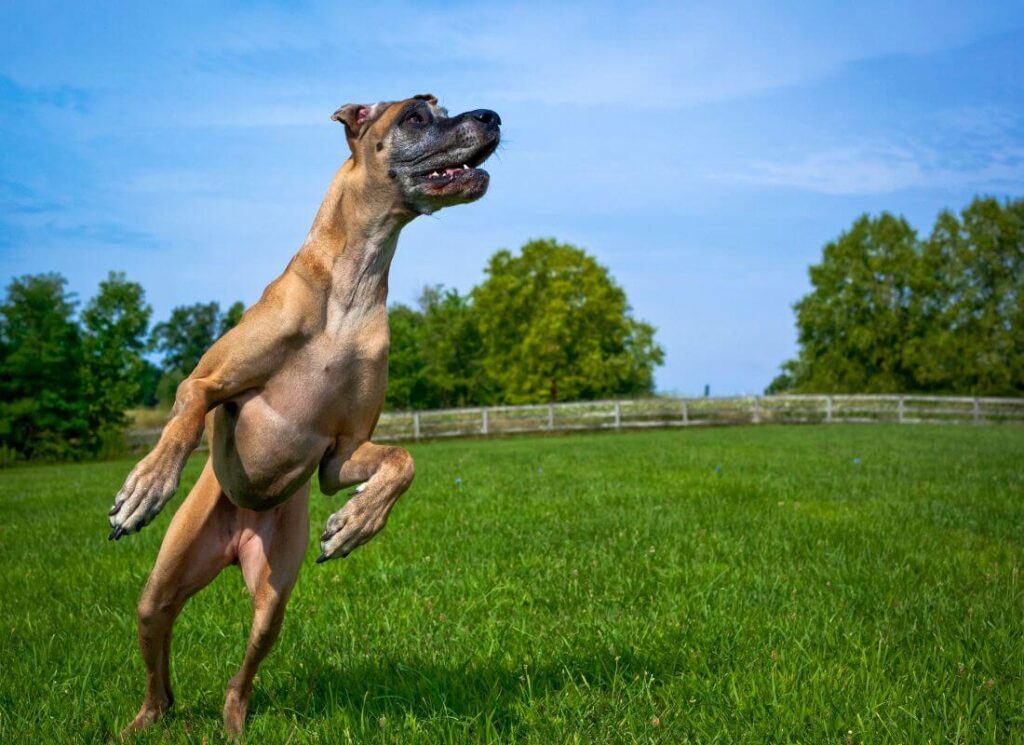
Why Do Great Danes Jump Fences?
If you really, truly want to stop this behavior it’s extremely helpful to address the root cause. Many owners want to skip this step (understandably) but it’s one of the most powerful tactics to stop fence jumping.
Take a look at the information below and give yourself an honest assessment of your Great Dane. What can you do to resolve or eliminate some of these factors?
1. Curiosity and exploration
Dogs, by nature, are curious beings, and Great Danes are no exception. Their inquisitive nature can drive them to explore their surroundings, often leading them to attempt jumping over fences in an effort to satisfy their curiosity.
Of course, Great Danes, being large and agile, may view the world beyond the confines of their yard as an enticing mystery waiting to be unraveled. This natural instinct for exploration, while a commendable trait, can pose challenges for dog owners aiming to maintain a secure environment.
If you have a super curious dog, look for ways to satisfy this curiosity by providing novel experiences as often as possible.
2. Social or environmental stimuli
Great Danes are known for their sociable nature and desire for interaction. The presence of other animals, people passing by, or even enticing stimuli from the outside world can act as powerful motivators for these dogs to attempt escaping the yard.
Recognizing and managing these social and environmental triggers is essential for preventing fence-jumping behavior and ensuring the safety and well-being of both the dog and the community. This is especially true if you have an intact Great Dane seeking to find a mate, or if your dog is aggressive and wishes to harm dogs or people walking by your property.
3. Lack of mental and physical stimulation
Great Danes have a lot of need for physical and mental enrichment. When these needs go unfulfilled, boredom and restlessness may set in, prompting dogs to seek alternative outlets for stimulation. In the absence of mental and physical engagement, a Great Dane may resort to fence-jumping as a means of alleviating monotony or pent-up energy.
Providing sufficient mental challenges through interactive toys, training sessions, and regular exercise can be instrumental in curbing this behavior, addressing the root cause of the issue and promoting a healthier, more contented canine companion.
While you might believe that offering toys or introducing a companion dog for play would eliminate any chance of your dog experiencing boredom, the reality is that, for many dogs, these measures fall short of satisfying their need for mental and physical stimulation.
To put this simply, bored dogs WILL jump fences, even if you think there is no way they could possibly be bored.
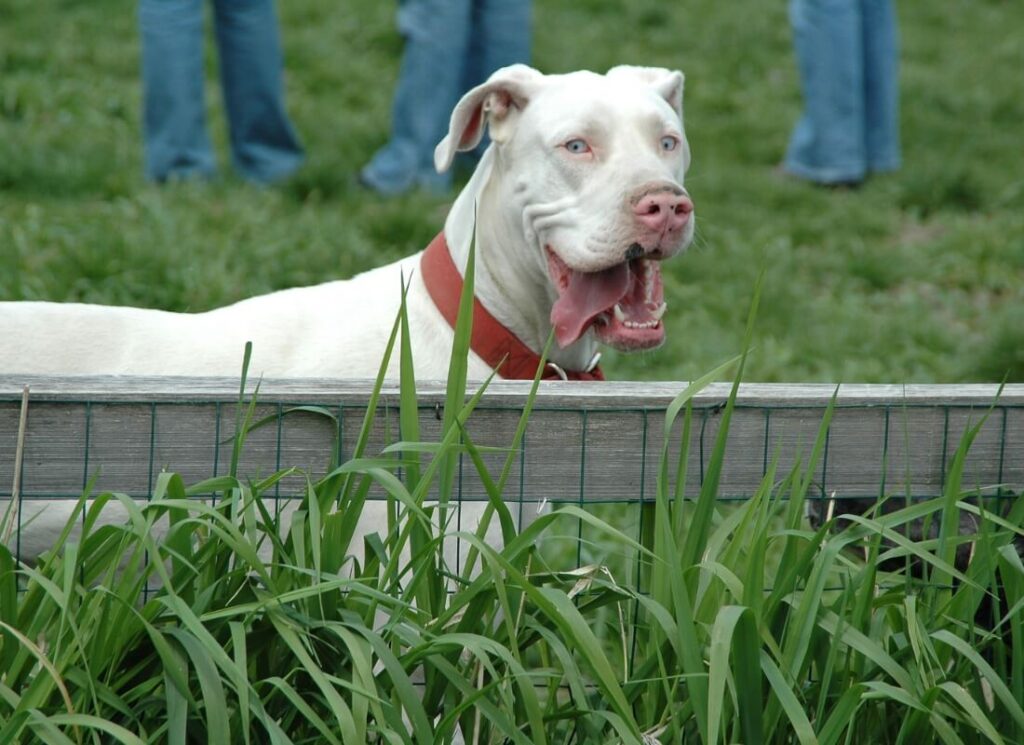
How to Stop a Great Dane from Jumping the Fence
There are four main steps to immediately stop dogs from escaping the yard.
- Address physical and mental needs (see above)
- Manage and prevent the behavior
- Secure the yard & make it hard to escape
- Train a new behavior
All four of these steps are likely required to ensure that your Great Dane will be reliable in a fenced yard, even if (like me) you only have 3-4 foot split rail!
Remember when I said that I had a Great Dane puppy jump the fence once? Oh yeah. I looked out of my kitchen window to see him romping in the snow with the neighbor dog. My neighbors were TICKED, even though both dogs were having a blast together.
It was several weeks before my sweet Dane pup was allowed in the yard off leash again…which brings me to step two of this process!
Step 1 – Address physical and mental needs
Remember, bored dogs will give themselves a job to do! Here are some fun ways to relieve boredom:
- Sit at a park and watch people
- Go on a sniff-exploration walk using a long leash
- Take a training class to learn how to be calm outside of the home
- Learning about scent work and tracking
- Feed meals out of puzzles
- Scatter feed (by chucking their food into the grass to find)
- Make the yard more interesting than being outside of the yard! Play lots of fun games together, add a small kiddie pool, hide treats for your pet to find, or make a digging pit for your dog
To put this simply, it’s very helpful that your yard and the time you spend with your dog in it should be more fun and more appealing than the allure of leaving the yard. Show your Great Dane that the grass really is greener on your side of the fence!
Step 2 – Manage & Prevent Fence Jumping
Assuming now that you’ve made some significant changes to your pet’s mental and physical enrichment routine, you can move onto this step.
I’m going to say something people don’t love…but if you have a dog that jumps fences, you MUST prevent the behavior by all means necessary.
This is a temporary measure that helps ensure safety, and puts a stop to tenacious dogs practicing the behavior of going on an adventure without you. Here are some tips to quickly stop your Great Dane from fence jumping:
- Use an ergonomic, sturdy harness (like THIS ONE) to safely secure your pet to a long leash
- If your pet will escape a harness, use a martingale collar WITH extra supervision
- Keep your pet on a leash in the yard. Ideally, you go outside with them; this is for safety and training reasons.
- Use a treat pouch full of high-value goodies to redirect your pet away from the fence (more on this in training)
- Triple check your fencing and make sure that it’s fully secure. If you have a smart Great Dane that can open the latch on your gate, lock it shut!
- Utilize trees, bushes, or hedges to block the view if possible
- Avoid being in the yard at times when other animals or people may be visible from afar (see ‘management’ below)
- Look around your yard at the places where your dog tends to jump over the fence. If there are low spots, find ways to block them!
Remember, many dogs can learn not to jump the fence and with time you can relax some of your management and supervision. Until then, this step is necessary. Your dog must never, ever, jump the fence again.
If they do? It’s your fault. Don’t let that fall on your shoulders!

Step 3 – Secure the Yard & Make it Hard to Escape
There are some incredible DIY projects to stop fence jumping and secure the yard! These don’t have to cost a lot of money, in fact, a lot of really good fence jumping solutions are very affordable.
DIY Coyote Roller to Stop Dogs from Fence Jumping
This is perhaps the most popular way to stop a Great Dane from jumping the fence. By installing coyote rollers on the perimeter of your yard, it will be very difficult for your dog to get enough grip to launch themselves into freedom.
Coyote rollers are made of cheap PVC pipe and do exactly what you think they will! When your Great Dane jumps up onto the edge of the fence, the roller will roll your dog right off.
Of course, this solution will not work if you have a dog that can clear a fence without touching it, or if your HOA is going to start sending you nasty letters about it. So think about what you are getting into before you apply this solution.
This fantastic article explains how to build coyote rollers to stop a dog from jumping the fence.
Adding a Trellis to Prevent Dogs from Jumping the Fence
A more HOA friendly solution to prevent fence hopping of shorter fences is to purchase tall trellis and grow plants on them! This solution works best for dogs that are easily deterred by simple boundaries.
I purchased 5 ft tall wire trellis at our local Costco store last summer and put them at the lowest spots along our split rail. They look nice and keep my big Dane from thinking he can use that area to leave the yard.
This solution may not work for 5+ foot fences.
Because they might not be available at Costco, I dug up a similar one on Amazon for you!
71″ Metal Garden Trellis 2 Pack
Bird Spikes to Prevent Dog Fence Jumping
Bird spikes are made to prevent birds from landing (and pooping) on things, but they work well for keeping cats, racoons, and dog paws off the top of the fence line. This type of solution works best for dogs that use the fence to hop over it (by putting their paws on the top first), and on fencing that is fairly solid along the edge (to secure the spikes).
20 feet of bird spikes come in a kit for around $14!
Make the Fence Taller
Of course, we cannot overlook the obvious solution for dogs leaving the yard. If you can afford it, and your HOA will allow, make your fence taller! Some Great Danes can live in homes with short fences, but others need a solid 6-7 foot boundary to stay safely in the yard. Privacy fence is ideal.
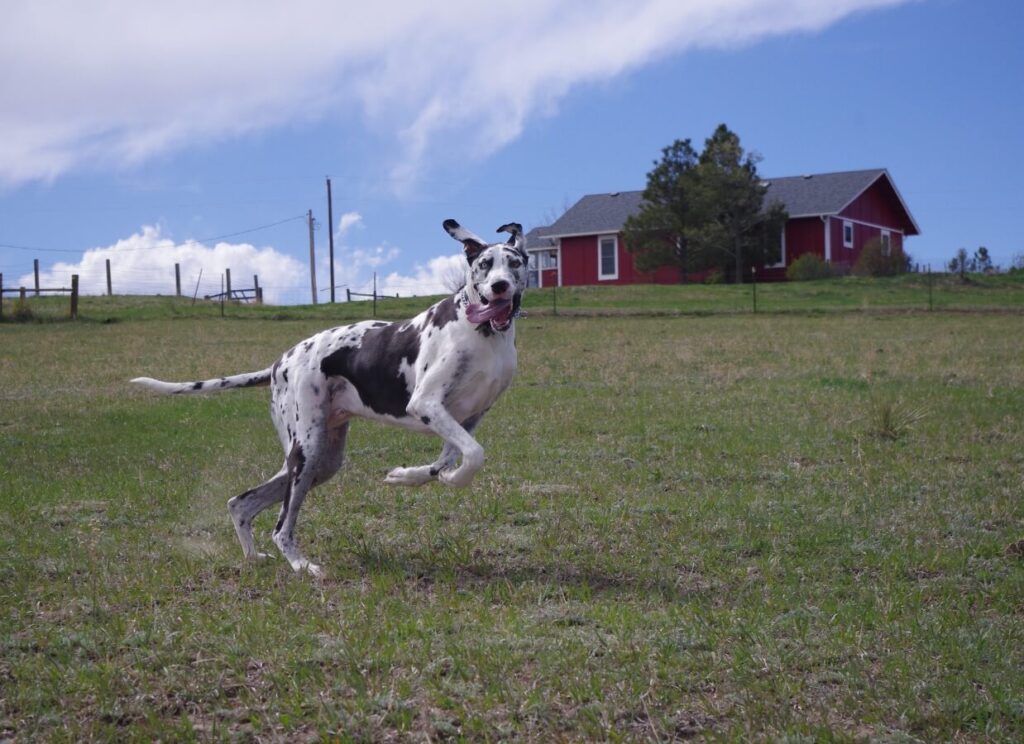
Step 4 – Train Your Great Dane Not to Jump the Fence
Now that you’ve applied all of the appropriate changes to management, activity, routine, and security it’s time to put a full stop to fence jumping. This requires a little more dedication on your part, but it’s important and well worth it!
I will break down the training steps below, but here is a basic run down:
- Train a rock solid recall (coming when called)
- Use boundary flags to teach the dog to turn away from the fence
- Use counter-conditioning to teach the dog to ignore outside influences (dogs or people walking by)
- If necessary, you can then also layer in an e-collar or invisible fence system
Train a ROCK SOLID Recall
Training a rock-solid recall, or getting your dog to come when called reliably, is an essential skill that ensures their safety and strengthens the bond between you and your Great Dane. Dogs with excellent recall are much less likely to jump the fence and if they do? They will come running back to you immediately. Here’s a step-by-step guide to achieving a dependable recall:
1. Start Indoors: Begin the training in a quiet indoor environment where distractions are minimal. Use a leash and collar or harness.
2. Positive Associations: Make coming to you a positive experience. Use treats, toys, or verbal praise to reward your dog when they respond to your recall command.
3. Use a Distinct Recall Command: Choose a specific and distinct recall command, such as “come” or “here.” Be consistent with the chosen command to avoid confusion. Do not ‘poison’ this cue by punishing your dog when they do come to you.
4. Short Distances First: Start with short distances when practicing recall indoors. Call your dog with an enthusiastic voice and reward them generously when they come to you.
5. Gradual Increase in Distance: As your dog becomes more reliable indoors, gradually increase the distance. Continue rewarding them for a successful recall.
6. Introduce Distractions: Move the training outdoors to a fenced area. Introduce mild distractions such as other people, mild scents, or toys. Practice the recall command in the presence of these distractions.
7. Leash Training: Attach a long leash to your dog’s collar or harness when training outdoors. This provides a safety net if your dog doesn’t respond immediately and helps you gently guide them back to you.
8. High-Value Rewards: Use high-value treats or toys for outdoor training to compete with more enticing distractions. Ensure that the rewards are more appealing than whatever may distract your dog.
9. Consistency is Key: Be consistent with your commands and rewards. Always reward your dog when they come to you, and avoid scolding if they take longer than expected.
10. Randomize Rewards: Occasionally reward your dog with surprise treats or extra enthusiastic praise to keep them motivated.
11. Practice Regularly: Regular practice is crucial for maintaining a strong recall. Even after your dog has mastered the command, continue occasional training sessions to reinforce the behavior.
12. Proofing: Gradually expose your dog to more challenging environments and distractions. This process, known as proofing, helps solidify the recall in various situations.
13. Use a Release Command: Introduce a release command (e.g., “okay” or “free”) to let your dog know they are no longer under your direct command. This helps prevent them from associating coming to you with the end of fun.
14. Patience and Positive Reinforcement: Training takes time, so be patient. Consistent positive reinforcement builds a strong foundation for a reliable recall.
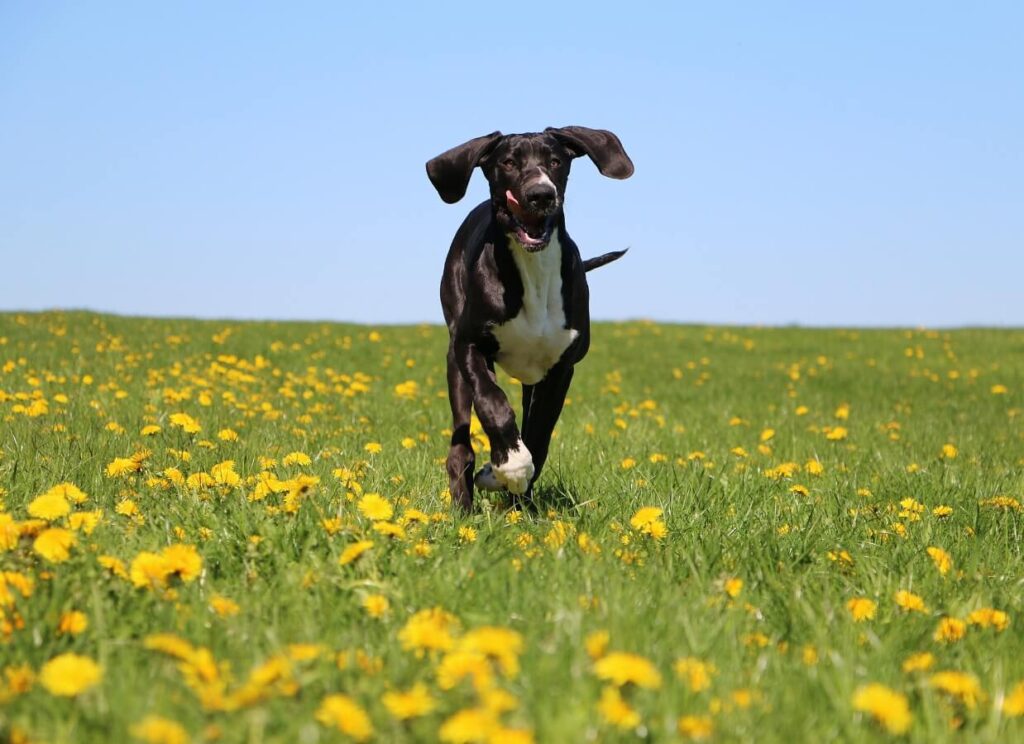
Use Boundary Flags to Teach the Dog to Turn Away from the Fence
Using boundary flags is an effective way to teach a dog to turn away from the fence and understand the limits of their designated area. This method is commonly employed with invisible dog fences, where the flags help create a visual barrier. Get Boundary Flags HERE.
Here’s a step-by-step guide:
1. Set Up the Flags: Place boundary flags along the perimeter of the designated area where you want your dog to learn the boundaries. Ensure the flags are visible and spaced consistently.
2. Introduce the Dog to the Flags: Allow your dog to become familiar with the boundary flags by letting them explore the flagged area on a leash. This helps them associate the flags with the boundaries.
3. Use Positive Reinforcement: Walk your dog along the perimeter while on a leash, and each time they approach the flagged area, say a command like “away” or “turn” and gently guide them away from the flags. Reward them with treats and praise when they comply.
4. Reinforce the Command: Repeat the process consistently, reinforcing the command and redirection away from the flags. Make the experience positive and enjoyable for your dog.
5. Gradual Off-Leash Training: Once your dog starts responding well on a leash, begin off-leash training in a secure, enclosed area. Continue using the command and rewarding positive behavior.
6. Increase Distractions: Gradually introduce distractions within the flagged area, such as toys or other pets. This helps reinforce the concept of turning away from the boundary even in the presence of tempting stimuli.
7. Correcting Unwanted Behavior: If your dog attempts to cross the boundary, use a verbal correction or a gentle tug on the leash to guide them back. Be consistent in redirecting them away from the flagged area.
8. Supervised Freedom: Allow your dog supervised freedom within the designated area, reinforcing the training regularly. Be attentive to any signs of potential boundary testing.
9. Expand Training to Unflagged Areas: Once your dog consistently respects the flagged boundaries, gradually remove the flags. Continue the training without the visual cues, reinforcing the verbal command.
10. Regular Reinforcement: Periodically reinforce the training by walking your dog around the perimeter, using the command, and rewarding compliance. This helps maintain the learned behavior over time.
11. Be Patient and Consistent: Training takes time, and every dog learns at its own pace. Be patient, consistent, and positive throughout the process.
12. Monitor and Adjust: Monitor your dog’s behavior around the boundaries, especially during periods of excitement or new distractions. Adjust the training as needed to address any challenges that may arise.
Using boundary flags to teach a dog to turn away from the fence requires patience, consistency, and positive reinforcement. By following these steps, you can create a clear understanding of boundaries, promoting a safe and secure environment for your dog.

Use Counter-Conditioning to Teach the Dog to Ignore the World Outside of the Fence
Counter-conditioning is a powerful training technique that can be used to teach a dog to ignore the world outside of the fence, especially when they exhibit reactivity or excessive interest in the World outside of your yard. This method involves changing the dog’s emotional response to a particular trigger, in this case, the sights and sounds beyond the fence. Here’s a step-by-step guide:
1. Identify Triggers:
Determine specific triggers that cause your dog to become reactive or overly interested in the world outside the fence. This could include people passing by, other animals, or environmental stimuli.
2. Choose a Safe and Controlled Environment:
Begin training in a quiet and controlled environment where you can manage the distance between your dog and the trigger stimuli.
3. Establish a Relaxation Zone:
Set up a designated relaxation zone within the fenced area where your dog can comfortably observe the triggers from a safe distance.
4. Introduce High-Value Rewards:
Use high-value treats or toys that your dog loves. These treats should be particularly enticing and reserved for this training.
5. Observe Trigger Stimuli from a Distance:
Allow your dog to observe the trigger stimuli from the relaxation zone. As soon as your dog notices the stimuli but remains calm, immediately reward them with a treat and praise. The goal is to create positive associations with the triggers.
6. Gradual Desensitization:
Gradually decrease the distance between your dog and the trigger stimuli over several sessions, but only if your dog remains calm. If they show signs of stress or reactivity, increase the distance again.
7. Consistency is Key:
Be consistent with your rewards and praise. Reward calm behavior promptly to reinforce the connection between remaining calm and receiving positive reinforcement.
8. Use Verbal Cues:
Introduce a verbal cue (e.g., “ignore” or “leave it”) while rewarding your dog for calm behavior. Eventually, your dog will associate the cue with ignoring the trigger stimuli.
9. Practice Regularly:
Consistent practice is essential for success. Aim for short, frequent training sessions to reinforce the desired behavior.
10. Increase Difficulty Gradually:
As your dog becomes more proficient at ignoring trigger stimuli, gradually introduce more challenging scenarios, such as increased activity or novel stimuli.
11. Generalize the Behavior:
Practice in various locations and with different stimuli to generalize the behavior. This helps your dog generalize the concept of ignoring external triggers.
12. Patience and Positive Reinforcement:
Patience is crucial. Remember that changing behavior takes time. Continue reinforcing positive behavior and be patient as your dog learns to ignore the world beyond the fence.
13. Seek Professional Help if Needed:
If your dog’s reactivity is severe or you encounter difficulties, consider seeking the assistance of a professional dog trainer or behaviorist.
By implementing counter-conditioning techniques consistently and with patience, you can teach your dog to ignore the world outside of the fence, fostering a calmer and more relaxed demeanor in various environments.
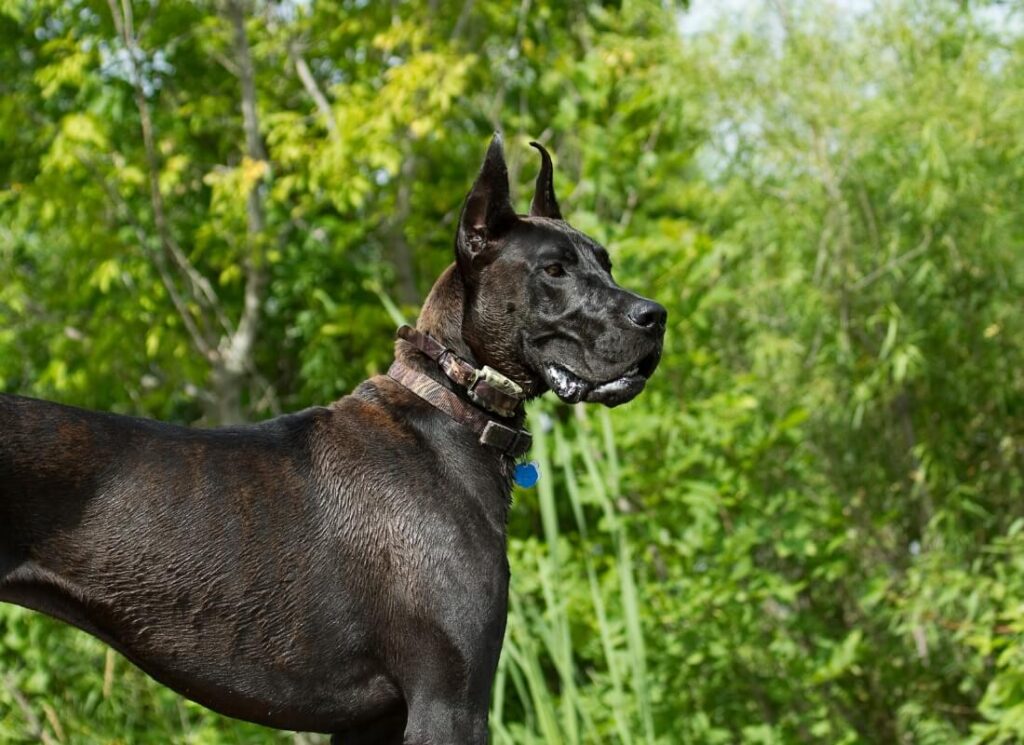
Add an E-Collar or Invisible Fence System
For dogs that still need an extra layer of security to keep them in the yard, we recommend a high quality e-collar or invisible fence system. It is much better and much safer for a dog to feel a small discomfort than it is for them to be hit by a car; so please disregard anybody who considers this last step somehow inhumane or inappropriate. There are times when this is the safest and most ethical response to fence jumping!
E-Collars for Stopping Fence Jumping
We only recommend E-Collar Technologies collars. There are two models that are fantastic for training Great Danes:
Mini-Educator (Awesome entry level model for those new to modern E-collar training)
EZ Educator (More robust model with more features)
To properly use an E-Collar, you must first condition your dog to understand what the communication from the collar means, first.
Start by placing the collar on your dog without activating any stimulation. Offer treats, praise, and play to create positive associations with the collar. During this introductory phase, ensure that your dog remains calm and comfortable. Gradually introduce the sensation of the e-collar’s stimulation at the lowest level, using positive reinforcement immediately afterward.
Repeat this process over several sessions, gradually increasing the stimulation levels only to the point that your dog is happily running towards you when they feel it. Always prioritize positive experiences, associating the e-collar with rewards, and maintaining a calm environment. Consistency and gradual progression are key to successfully conditioning your dog to the e-collar while preserving a trusting and positive bond.
PRO TIP: For a device from Educator Technologies, most dogs are very responsive between levels 3-10. Anything higher than that is corrective and should not be done during the conditioning phase.
Now that your pet is conditioned to the collar, you can use it for correcting them at the fence line.
1. Associate the Fence with Correction: When your dog approaches the fence with the intention of jumping, use a command such as “no” or “stop” before activating the e-collar. This helps your dog associate the correction with the unwanted behavior.
2. Apply Progressive Correction: If your dog continues to approach or attempt to jump the fence, use the progressive continuous correction feature on the e-collar. Start with a low level and gradually increase as the behavior persists.
3. Immediate Release of Stimulation: The correction should immediately cease when your dog stops the undesired behavior. This ensures your dog associates the correction with the fence-jumping behavior, and the removal of the correction when they make the right choice.
The Best Invisible Fences for Great Danes
If you are interested in automating the process of correcting your dog for attempting to leave the yard, consider an invisible fence as added protection. This solution comes with some caveats, however.
- Some dogs learn to blow through the correction
- The collars have to be worn and rotated constantly
- This requires diligent boundary training
- Invisible fencing doesn’t keep other dogs OUT of the yard (if there is no physical fence)
- It’s expensive
- Hard to install – for fence jumping, the wired invisible fence system is necessary
There are two invisible fence systems we recommend for Danes.
Halo GPS Dog Off Leash Collar
The Dogtra wired system consists of an underground wire, buried around the perimeter of the designated area, and a collar worn by the dog that is equipped with a receiver. As the dog approaches the boundary, the collar emits a warning signal, followed by vibration and/or a mild static correction if the dog continues to move closer.
The training process involves the dog learning to associate the warning signal with the boundary, facilitating self-correction over time. This invisible yet secure containment method provides dogs with the freedom to roam within predefined limits while ensuring their safety.
The wired e-fence is particularly useful for properties where traditional physical fences might be impractical, unreliable, or aesthetically undesirable, offering pet owners a reliable means of keeping their dogs safely within designated areas. Regular training, positive reinforcement, and careful installation are crucial components of a successful and humane wired e-fence containment system.
We’ve said this before and we will see it again: we would MUCH rather a dog experience a small static correction than be hit by a car.

Leave a Reply